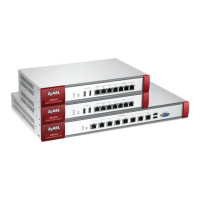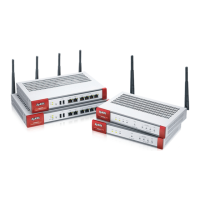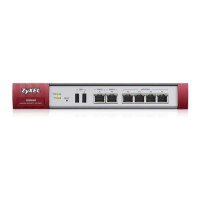ZyWALL USG Series User’s Guide
296
CHAPTER 10
Interfaces
10.1 Interface Overview
Use the Interface screens to configure the Zyxel Device’s interfaces. You can also create interfaces on
top of other interfaces.
• Ports are the physical ports to which you connect cables.
• Interfaces are used within the system operationally. You use them in configuring various features. An
interface also describes a network that is directly connected to the Zyxel Device. For example, You
connect the LAN network to the LAN interface.
• Zones are groups of interfaces used to ease security policy configuration.
10.1.1 What You Can Do in this Chapter
• Use the Port Role screen (Section 10.2 on page 301) to create port groups and to assign physical ports
and port groups to Ethernet interfaces.
• Use the Port Configuration screen (Section 10.3 on page 302) to configure Zyxel Device port settings.
• Use the Ethernet screens (Section 10.5 on page 304) to configure the Ethernet interfaces. Ethernet
interfaces are the foundation for defining other interfaces and network policies. RIP and OSPF are also
configured in these interfaces.
• Use the Virtual Interface screen (Section 10.5.3 on page 327) to create virtual interfaces on top of
Ethernet interfaces to tell the Zyxel Device where to route packets. You can create virtual Ethernet
interfaces, virtual VLAN interfaces, and virtual bridge interfaces.
• Use the PPP screens (Section 10.6 on page 331) for PPPoE, PPTP or L2TP Internet connections.
• Use the Cellular screens (Section 10.7 on page 338) to configure settings for interfaces for Internet
connections through an installed mobile broadband card.
• Use the Tunnel screens (Section 10.8 on page 347) to configure tunnel interfaces to be used in
Generic Routing Encapsulation (GRE), IPv6 in IPv4, and 6to4 tunnels.
• Use the VLAN screens (Section 10.9 on page 353) to divide the physical network into multiple logical
networks. VLAN interfaces receive and send tagged frames. The Zyxel Device automatically adds or
removes the tags as needed. Each VLAN can only be associated with one Ethernet interface.
• Use the Bridge screens (Section 10.10 on page 368) to combine two or more network segments into a
single network.
• Use the LAG screens (Section 10.11 on page 382) to combine multiple physical Ethernet interfaces
into a single logical interface.
• Use the VTI screens (Section 10.12 on page 389) to encrypt or decrypt IPv4 traffic from or to the
interface according to the IP routing table.
• Use the Trunk screens (Section 10.13 on page 394) to configure load balancing.

